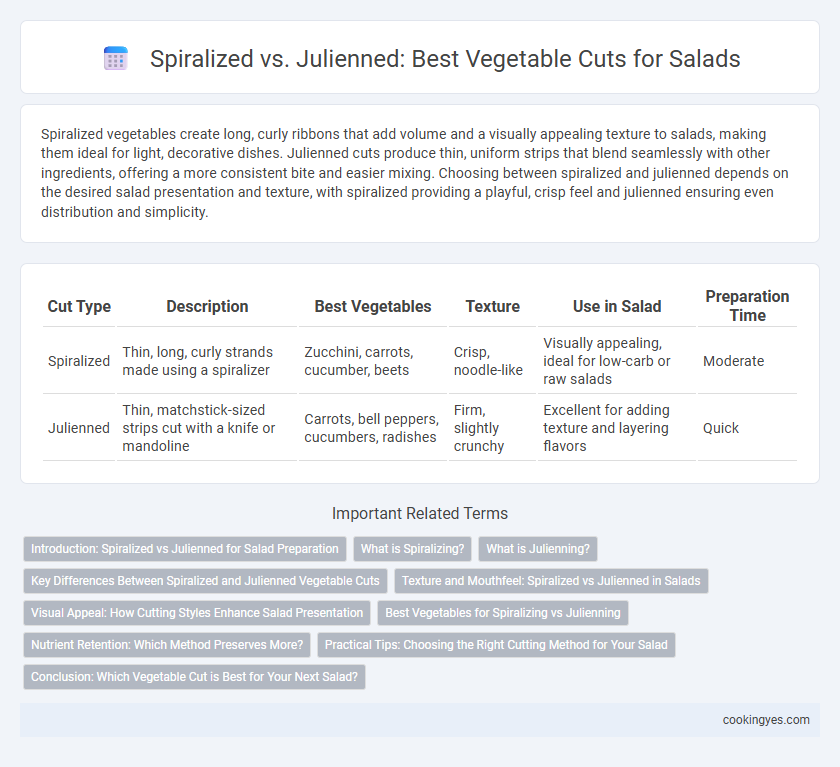Spiralized vegetables create long, curly ribbons that add volume and a visually appealing texture to salads, making them ideal for light, decorative dishes. Julienned cuts produce thin, uniform strips that blend seamlessly with other ingredients, offering a more consistent bite and easier mixing. Choosing between spiralized and julienned depends on the desired salad presentation and texture, with spiralized providing a playful, crisp feel and julienned ensuring even distribution and simplicity.
Table of Comparison
| Cut Type | Description | Best Vegetables | Texture | Use in Salad | Preparation Time |
|---|---|---|---|---|---|
| Spiralized | Thin, long, curly strands made using a spiralizer | Zucchini, carrots, cucumber, beets | Crisp, noodle-like | Visually appealing, ideal for low-carb or raw salads | Moderate |
| Julienned | Thin, matchstick-sized strips cut with a knife or mandoline | Carrots, bell peppers, cucumbers, radishes | Firm, slightly crunchy | Excellent for adding texture and layering flavors | Quick |
Introduction: Spiralized vs Julienned for Salad Preparation
Spiralized and julienned vegetable cuts offer distinct textures and visual appeal in salad preparation, enhancing the eating experience. Spiralizing creates long, curly strands that add a playful, noodle-like element, ideal for zucchini or cucumber, while julienning produces thin, matchstick-sized strips that provide a crisp, uniform bite perfect for carrots or bell peppers. Choosing between these techniques depends on the desired salad presentation and texture, influencing both flavor distribution and overall mouthfeel.
What is Spiralizing?
Spiralizing is a culinary technique that transforms vegetables into long, curly ribbons or noodle-like strands using a specialized spiralizer tool, enhancing texture and visual appeal in salads. This method is particularly popular for creating vegetable-based alternatives to traditional pasta, making salads more nutritious and low-carb. Spiralized vegetables such as zucchini, carrots, and cucumbers retain their crispness and are easy to mix with dressings and other salad ingredients for a fresh, vibrant dish.
What is Julienning?
Julienning is a precise knife technique that transforms vegetables into thin, matchstick-like strips, typically about 1/8 inch wide and 1 to 2 inches long, offering uniform texture and quick cooking. This cut enhances the salad's visual appeal and allows for even dressing distribution, creating a balanced flavor profile. Commonly applied to carrots, cucumbers, and zucchini, julienned vegetables add a crisp, fresh crunch that complements mixed greens and other ingredients.
Key Differences Between Spiralized and Julienned Vegetable Cuts
Spiralized vegetable cuts create long, curly ribbons that add volume and a visually dynamic texture to salads, while julienned cuts consist of thin, straight matchstick-like strips that provide a uniform crunch and delicate bite. Spiralized cuts are typically thicker and ideal for zucchini or carrots, enhancing a dish's aesthetic appeal, whereas julienned cuts are finer, allowing for better integration with other ingredients and a more balanced flavor distribution. Both techniques influence the salad's mouthfeel and presentation, but choosing between them depends on the desired texture and overall composition of the dish.
Texture and Mouthfeel: Spiralized vs Julienned in Salads
Spiralized vegetable cuts create long, curly strands that offer a tender, noodle-like texture, enhancing the salad's chewiness and providing a satisfying mouthfeel. Julienned cuts produce thin, uniform strips that maintain a crisp bite, contributing to a refreshing crunch and crisp texture in salads. Choosing between spiralized and julienned vegetables largely depends on the desired texture contrast and overall sensory experience in the salad.
Visual Appeal: How Cutting Styles Enhance Salad Presentation
Spiralized vegetable cuts create long, curly strands that add dynamic texture and volume, making salads visually striking and playful. Julienned cuts offer thin, uniform strips that provide a clean, elegant look, enhancing the salad's structured presentation. Both techniques emphasize freshness and color, elevating the overall appeal and making salads more enticing to eat.
Best Vegetables for Spiralizing vs Julienning
Spiralized vegetables like zucchini, carrots, and cucumbers provide a light, curly texture ideal for fresh salads, while julienned cuts of bell peppers, radishes, and jicama offer crisp, uniform strips that enhance visual appeal and crunch. Spiralizing works best with firm, long vegetables that hold their shape, whereas julienning adapts well to a wider variety including root vegetables and softer produce. Selecting the appropriate cut not only affects salad presentation but also influences texture and flavor integration.
Nutrient Retention: Which Method Preserves More?
Spiralized vegetable cuts retain more nutrients due to minimal surface area exposure and slower oxidation compared to julienned cuts, which have greater exposed surfaces leading to quicker nutrient degradation. The spiralizing process also preserves fiber integrity and vitamin C content, essential for salad freshness and health benefits. Selecting spiralized cuts enhances the nutritional profile and texture of salads, making them a superior choice for nutrient retention.
Practical Tips: Choosing the Right Cutting Method for Your Salad
Spiralized cuts create long, curly ribbons that add volume and a playful texture to salads, ideal for zucchini or carrots when aiming for a noodle-like presentation. Julienned cuts produce thin, matchstick-sized strips that provide a crisp, uniform bite perfect for denser vegetables like cucumbers or bell peppers. Opt for spiralizing to enhance visual appeal and tenderness, while julienning offers a refined, consistent texture that blends well in mixed greens.
Conclusion: Which Vegetable Cut is Best for Your Next Salad?
Spiralized vegetable cuts offer a visually appealing, noodle-like texture ideal for light, fresh salads, enhancing crunch and flavor absorption. Julienned cuts provide uniform thickness that ensures even cooking and a consistent bite, perfect for hearty or warm salads with diverse ingredients. Selecting between spiralized and julienned depends on salad type and desired texture, with spiralized enhancing raw, crisp salads and julienned suiting mixed or cooked vegetable preparations.
Spiralized vs Julienned for Vegetable Cuts in Salad Infographic

 cookingyes.com
cookingyes.com